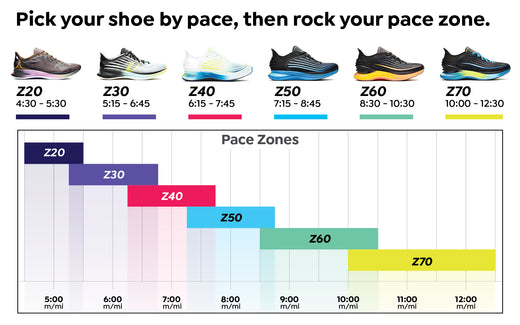Supercritical Foam & Midsole Responsiveness
One of the current buzzwords in the running industry is supercritical, as in supercritical midsole foams. This refers to a manufacturing process for creating foam midsoles. Nearly every running brand out there touts their use of supercritical nitrogen in the foaming process to make their midsoles more "responsive." I’ll describe what supercritical foam is all about, but the point of this post is to clarify the meaning of the other buzzword: responsive. What do we mean by it, and is it relevant.
Midsole foam is a lot like bread: small bubbles expand inside an elastic matrix (like dough) to make a solid that is much lower density than the original material. When the material cools, a foam structure is permanently set and the bread, unlike a soufflé, keeps its new shape and density. In bread, the chemical bonds in the gluten are much weaker than in shoe materials (fortunately!), and a little moisture and chewing easily breaks them down. The polymers in midsole foams are designed to be the opposite of bread, so they don’t break down, no matter how much moisture and mashing we expose them to.
 Thankfully, we don't run on bread or eat midsoles!
Thankfully, we don't run on bread or eat midsoles!
There are many polymers and combinations of polymers used in manufacturing foams to meet specific performance criteria. The foam in the seat of your car, for example, has a polymer mix different from the foam in the dashboard, different from the foam in the steering wheel. Each application has different requirements for durometer, elasticity, stability to heat, longevity in the presence of ozone, and many many more properties.
The chemical giants specialize in these things. Shoe midsoles are made with polymer mixes that emphasize low density and the ability to rapidly return to an original form after compression. There are many polymer mixes that can achieve the same density, durometer, and elasticity and each chemical supplier has their own branded version. EVA as the base polymer has been popular for the longest time, while in recent decades TPU and PEBA have also become common. At a very granular level, there are definitely differences in the end product depending on the polymer used. The question is, however, are the differences in polymers relevant to running? We’ll come back to that question in a moment.
Supercritical foam is made from the same basic polymers as other foams, but the manufacturing process is different. The process involves nitrogen in a supercritical state. The thing to remember is that nitrogen is the preferred molecule—because it's inert and ubiquitous—but the finished midsole doesn’t actually contain supercritical nitrogen. Unlike replacing CO2 in beer with nitrogen, nobody cares how shoes taste! (If you're curious to learn more about supercriticality, the wiki page is a good primer.)
Back to responsiveness and the question: Is supercritical foam relevant to running? When responsiveness is defined, and usually it isn’t, it’s defined in terms of spring damping. The way it's talked about, the more responsive means less damping. If the foam were shaped into a ball, a more responsive foam would bounce higher when dropped. Of course, if the ball is dropped and not thrown down, it can’t bounce higher than its original starting height. But the closer the ball comes to the original height, the less damping and energy loss occurs during the bounce. In engineering, the ratio of bounce height to initial height is called the quality Q and has a maximum value of 1 (the ball returns to the height from which it was dropped). So more responsive means higher Q, means less damping. That’s good, right? But the question is, is it relevant?
Answering the question of relevance means diving headfirst into the physics of running. Don’t worry, we can get the gist of it without math. The main thing to remember is that running uses two legs. This seemingly trivial fact is generally ignored in biomechanics, and instead, running is approached as though you can mentally hack the foot off at the ankle, drop it on the ground, and watch it bounce.
But when you think about both legs moving to create a sequence of strides, you can understand how lifting the swing leg generates a force on the ground just as straightening the support leg. Even with a straight and stiff support leg, lifting the swing leg generates a force on the ground. You can also see how the time it takes to create the force is a function of the cadence. A change in cadence means a change in how quickly the swing leg moves forward and up. Of course, the support leg is moving simultaneously—the two legs are joined at the hip—and the two legs move 180 degrees out of phase. The slower the cadence, the longer the time on the ground pushing off.

Contrast the cadence of controlled running motion with a material controlled midsole foam. A midsole foam will bounce back in the same amount of time no matter what the runner’s cadence is. This is a physical property of any elastic foam, whether it is made with supercritical nitrogen or with regular air. The point is, the responsiveness of a foam is only relevant if the time period of the force generated by a runner is the same as the time period for a bounce in the foam.
Since the foam’s period for force is determined by fixed physical properties (and total runner mass) and the runner’s period for force is determined by cadence, the two are never the same. Why? It turns out, in fact, for any midsole—super shoe or otherwise—and for human running—elite or jogger—the periods differ by a factor of five. Because of this difference, the responsiveness of a foam cannot be relevant to running or force generation more accurately.
Just to be clear, the above description does not ignore the other factors that determine the periods of force. For example, runner height, stride length, slope of the ground, and air drag are also determinants. The point is that regardless of the magnitude of the forces in running, the consequences for the energy involved in running in soft shoes depends on the time periods. Since the runner’s force time period doesn’t match the midsole foam’s rebound period exactly, the responsiveness has no effect on the energy of the runner. Foam responsiveness, therefore, is irrelevant to every runner.
If having to think about energy and forces and time periods and cadence makes your head swim, just go back to the fundamental definition of running as involving two legs and forget about any description of running as a bouncing ball. With two legs, we can run uphill and can control our speed going downhill. Try bouncing up a hill sometime, not hopping, and see how far you get.




